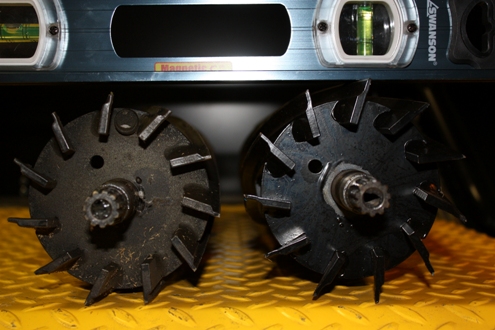First designed by Edwin Budding in 1830 and licensed for manufacture by Ransomes (now part of Jacobsen), the reel mower still provides the best quality-of-cut on most types of grasses.
For sports turf managers consistently cutting at or below 2 ¼ inches, especially on warm-season grasses, reel mowing will provide far superior results. Rather than chopping the grass like a rotary blade, reel mowers use a scissor-like action that shears each blade of grass. The result is a superior after-cut appearance and healthier plant tissue.
Reel mowers are inherently more sophisticated than rotary models and require more maintenance, monitoring and adjustment.
The scissor-like action of a reel mower is created by two main components: the reel cylinder and a bedknife. The bedknife is a long blade that stands up the grass before the cylinder blades swing through and shear it. It is critical that the reel and bedknife are both sharp and the space between them is uniform and consistent. Industry standards call for between .001” and .003” clearance between the reel and bedknife.
Quality-of-cut issues most often arise from dull reels and/or bedknives. Sharpness should be at the top of your mower maintenance list and be viewed as a starting point for proper setup.
“Going out to mow with dull reels and bedknives is like running a stock car race with improperly inflated tires,” said Lynn Westbrook, principal engineer at Jacobsen. “You’ll never get the performance you need and the results will be less than perfect. It’s amazing how many guys out there either forget or neglect reel and bedknife sharpness.”
Most sports field managers will regularly send out their reels to be ground and sharpened. But reels can come out of adjustment during transport, daily service or mowing. So how do you know when it’s time to bring in your reels for service?
“Reel issues will almost always show themselves in the grass,” says Greg Walker, technical training manager for Jacobsen. “Take a close look at the grass after a fresh mow. If you’re seeing an uneven cut, defined lines or marking in the grass after mowing, you may have an issue. Also, take a look at the clippings: are the blade edges nice and straight or ragged and torn? The latter result may indicate a need for more frequent service.
“One simple maintenance practice that shouldn’t be overlooked is backlapping,” adds Walker. “It’s easy for any operator or field manager to do in just a few minutes at the end of the day. You just spread some compound on the reel and set it to backlap mode, which spins the reel in reverse at a low RPM. It’s a quick and easy way to stay sharp with every mow and extends the life of the reel and bedknife and the time between grinds.”
In a pinch, sharpening the front face of a bedknife with a facing tool or hand grinder will provide great results in an emergency.
In addition, a simple “paper test” should be done before and after each mow. To conduct a paper test, simply insert a piece of paper between the reel and bedknife and rotate the reel slightly to see if it cuts the paper cleanly. Repeat this all the way down the length of the bedknife. If the reel does not cut the paper in any areas, it may be time for a grind.
While your reels and bedknives are being ground, it’s critical not to overlook the rollers, roller bearings, reel bearings, etc. to ensure a stable grind. Any play in the rotating components can cause the reel or bedknife to move during a grind. Ask your grinding service if they check related components before grinding.
Although reels and bedknives were made to be regularly ground and sharpened, they will eventually wear down past the point of repair. Reels were designed to work within certain parameters. Going beyond the manufacturer’s reel diameter tolerance limit alters the original geometry of the reel and bedknife setup. “For example, on a 5-inch reel, you don’t want to get below a 4.5 inches in diameter,” said Westbrook. “When you see the reels worn past that diameter, the reel is simply unable to provide a good quality-of-cut.”
When it is time to replace reels and bedknives, it always pays to buy OEM parts. “If there’s any two parts you should buy directly from the manufacturer it’s the reel and bedknife,” said Westbrook. “They are designed to work together and have very precise metallurgy to ensure the highest performance. When you add in a ‘may-fit’ reel or bedknife into the mix, the performance of the machine will be sacrificed and the results will show up in the grass. Another benefit of sticking with OEM bedknives and reels is that you have the backing and support of a manufacturer if you happen to run into any issues.”
You will also want to make sure that your mowers are cutting at the desired height. There is typically a variance between the bench setting (what the height-of-cut is set at when it leaves the shop) and what height the grass is actually cut at. It’s worth the investment in a turf prism, which will give you a more accurate reading of the quality-of-cut your mowers are providing.
To maximize the investment you’ve made in your mowers, ensure optimal machine performance, and ultimately provide the best quality surface for your players, be sure to make reel and bedknife maintenance part of your regular routine.


